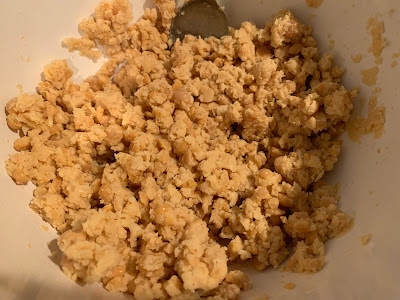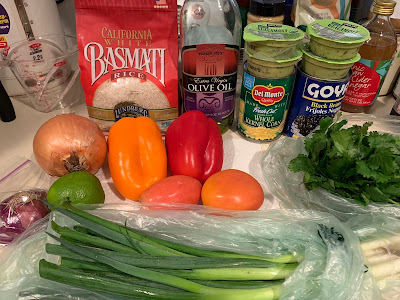I felt all sorts of emotions when the first challenge of 2021 came up as last meal. I was sad, angry, and upset, because what kind of challenge theme was that?! Coming off of a 2020 that saw such tragedy, why would you start off the year with something so depressing, dark, and dreary? Why wouldn't you want to look ahead to 2021 and try to start it on a bright, optimistic note? [I wrote most of this post before the insurrection... What a start to the year.] Who wants to think about having their last meal at a time when COVID is surging? What an incredibly morbid theme. I was kind of surprised that they went there at all during a pandemic, but especially for the opening theme of the year. I also felt disappointed. I don't like skipping weeks, especially not the first one, but there was also no way I was going to participate in this thought exercise.
I apparently wasn't the only one that felt that way, and there were lots of comments on Reddit from people who found the theme similarly bleak. Some took it to even darker, sadder places, like what it would mean to have the same last meal as someone executed on death row. Not things I want to think about to set the tone for the year. Thankfully, other people came up with less negative lenses through which to view the challenge, one of which was the last meal of the Before Times, the last meal out before lockdown, the last meal at a restaurant before the entire world closed down. For us, the last time we ate out before everything started to get shut down was a family meal at Qdoba. It's a really happy memory for me, just being able to see and eat with family in the middle of so much uncertainty (as we could definitely feel the coronavirus dangers lurking at the time), and B was having a great time at that dinner, dancing to the music and enjoying his Mexican food. So, our challenge meal was set - copycat burrito bowls.

There were a lot of moving pieces for this dinner if we were going to make our own burrito bar, and I don't think I really anticipated just how involved it was, so I started making dinner way too late. The whole process took about 2.5 hours, which meant another late challenge dinner. Outside of the guacamole, for which we just used Kirkland guacamole singles, there were six different dishes made from scratch: copycat Qdoba grilled chicken, cilantro lime rice, fajita vegetables, black beans, corn, and pico de gallo. The black beans and corn weren't going to be replicas of Qdoba, just quick microwavable dishes since I did not have the time for that, but I wanted to make our burrito bowls as similar as possible otherwise.
The ingredients were:
- 1.5 lbs chicken tenders ($8.99)
- big spoonful of minced garlic ($0.05)
- 2 tbsp olive oil ($0.20)
- about 1 tbsp chili powder ($0.10)
- about 1 tsp cumin ($0.05)
- about 1 tsp oregano ($0.05)
- salt and freshly ground black pepper ($0.03)
- adobo sauce ($0.58)
(Note that the recipe called for 2 tbsp of adobo sauce, but I didn't have any and wasn't sure if it would be too spicy for B, so I went with
a substitute I found on Pepper Scale, omitting the cayenne. I ended up using about 1 tbsp tomato paste, 1 tbsp apple cider vinegar, about 1 tsp smoked paprika, about 1/2 tsp cumin, a pinch of oregano, and a pinch of garlic powder, again not measuring the dry spices, with the total approximate cost reflected in the list above. I mixed that together first, and it tasted far closer to adobo than I thought it would, lacking some of the depth and not very spicy, but that was just what I needed here!)
- 1 cup basmati rice ($1)
- juice of 1/2 lime ($0.25)
- 2 cups water ($0)
- about 1 tsp salt ($0.02)
- 1/2 big bunch of cilantro, finely chopped ($0.44)
- about 3 tsp olive oil, divided ($0.10)
for the fajita vegetables:
- olive oil spray ($0.30)
- 1 orange bell pepper, sliced into strips ($1)
- 1 red bell pepper, sliced into strips ($0.91)
- 1 large yellow onion, sliced into strips ($0.79)
- salt ($0.02)
- oregano ($0.05)
for the black beans:
- 1 can black beans ($0.94)
- a little olive oil ($0.05)
- salt, black pepper, garlic powder, oregano ($0.08)
for the corn:
- 1 can corn ($0.96)
- scallions (see note with pico de gallo) ($0.20)
- a little olive oil ($0.05)
- salt, black pepper, garlic powder ($0.06)
for the pico de gallo:
- 2 roma tomatoes, diced ($0.81)
- 1/2 red onion, finely chopped ($0.39)
- 1/2 big bunch of cilantro, finely chopped ($0.45)
- 4 scallions, greens finely chopped, whites thinly sliced on the diagonal - split with the corn (all the whites used in the pico, 1/3 of the greens used in the pico and the rest in the scallions) ($0.23)
- juice of 1/2 lime ($0.25)
The cost for our burrito bar was approximately $22.90 ($10.05 for the chicken, $1.81 for the rice, $3.07 for the fajita vegetables, $1.07 for the black beans, $1.27 for the corn, $2.13 for the pico de gallo, and $3.50 for 3 packages of guacamole). Two burrito bowls plus a kid's meal at Qdoba runs us about $20-25, but while their portions are large, this was still more food than we would have gotten there. Well, maybe not more rice, but definitely more chicken.
The first thing I made was the chicken because it needed to marinate. I was too tired to do it the night before, so it ended up only marinating for about 4 hours or so. It was still delicious, but next time I think I would try to marinate it longer. I mixed the substitute adobo sauce first, then added the rest of the marinade ingredients, and then added the chicken tenders, stirring them around until they were all covered with sauce. The covered bowl sat in the fridge until it was time to grill.
Prep was the thing that took the longest. (Wish I had taken a photo of that mountain of cilantro!) I worked on the tomatoes, onions, peppers, scallions, and cilantro the bulk of the time, but after that the pico de gallo was done and mixed, ready to sit out and meld until everything else was done. A started on the rice while I finished the prep, which definitely helped get everything done.
For the rice, we basically followed the Skinnytaste instructions, which were to add the rice, a tsp of oil, water, and salt to the pot, boil it until the water just skims the top of the rice, cook covered on low for 20 minutes, and then keep it covered with no heat for at least 5 minutes. (We left it covered and steaming until everything else was done.) The last step was to mix the rest of the olive oil with the cilantro and lime juice into the rice.
After prepping, I moved on to the fajita vegetables, cooking them in a grill pan that was sprayed with olive oil. This was my first time using the grill pan for active cooking after seeing someone doing that on YouTube. Previously, I only ever put things on the pan to grill like you would on an outdoor grill, but the vegetables cooked exactly the way I wanted them to this way. They were still a little harder and crunchier than I would have preferred when they came off the pan, but I put them in a bowl covered with foil to steam until everything else was done, and the texture was perfect.

Once the vegetables were done, it was time to grill the chicken. A took over at the grill pan, so I could put together the bowls of black bean and corn in the microwave, and the timing worked out well. Even though our meat thermometer said they were done, a few of the pieces of chicken weren't fully cooked when I went to chop them after resting, so we threw them back in the pan. Even after that, the chicken was still juicier than what you normally get from Qdoba and Chipotle.

I wish I had gotten a photo of A's first bowl, because he made it look exactly like the ones we would get at Qdoba, piled high with a dollop of guacamole on the top. We were all really happy with this meal. I love burrito bowls, and it felt so good to have a from-scratch burrito bowl that we made in our own kitchen (other than the guacamole). The chicken flavoring was delicious, the rice was fluffy, the fajita vegetables were texturally great but just needed a little more seasoning, the black beans and corn were easy and tasty, and the pico de gallo added a bit of freshness. Although I love pico de gallo, it was actually my least favorite part, although A might be right that my opinion here is biased by the fact that it was also the thing that took the longest to prepare.

What would I do differently, since I would love to make burrito bowls part of our regular rotation? I would marinate the chicken longer. Otherwise, the marinade was great, and I'm glad we got pre-sliced tenders from the grocery store, which were perfect for this. I would add a little more seasoning to the fajita vegetables, but otherwise change nothing. I would omit the cilantro and maybe the lime from the rice, because the cilantro takes so long to prep and regular rice would be fine. I would buy pico de gallo from the store or just use salsa instead. (They didn't have any this time, which is why I made my own.) I would do the same thing with the corn and the black beans, since they were simple and quick. Basically, I would use some shortcuts to make it so that burrito bowls wouldn't take me 2.5 hours. If I didn't make my own pico de gallo and didn't prep any cilantro, then I could just make the rice while cooking the vegetables, and make the black beans and corn while grilling the chicken, and the whole thing would be so much faster. Can't wait to try that out in the future!



















